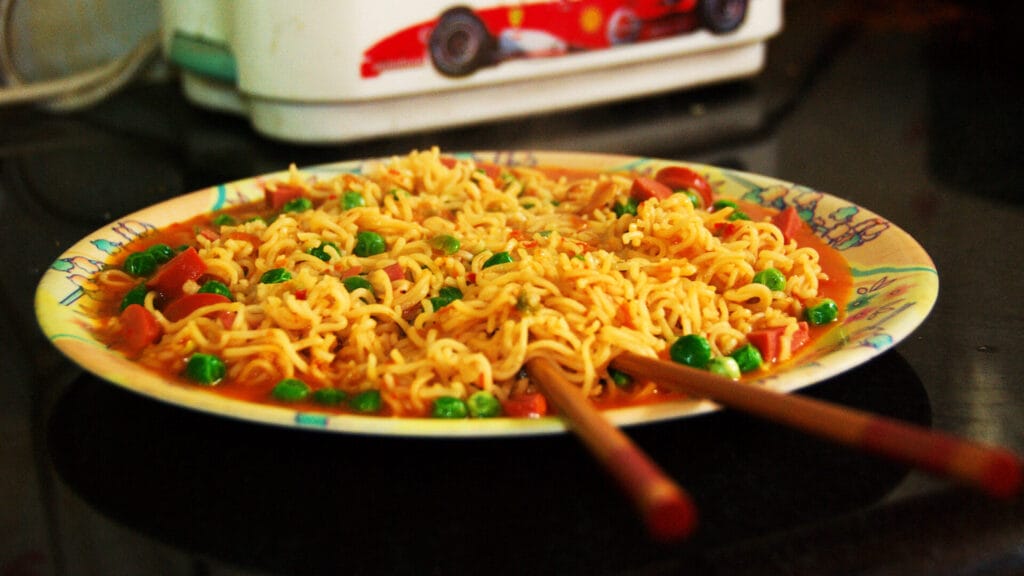Few can resist the temptation of taste bud-tickling instant noodles, refreshing fruity drinks, cold beverages, health drinks, bhujiyas, soy sticks, or cereals and confectionery products like biscuits and chocolates. A critical question, however, is whether they are even aware that all these pre-packaged items form a part of the harmful junk food brigade known as ultra-processed foods, or UPF, which are known to be associated with non-communicable diseases. What is more, these are often presented as healthy food options using misleading advertisements, as a recent report points out.
The report titled The Junk Push: Rising Ultra-processed Food Consumption in India -Policy, Politics and Reality, brought out by Nutrition Advocacy in Public Interest in India (NAPi) and Breastfeeding Promotion Network of India (BPNI), is based on a study of advertisements related to 43 pre-packaged food products: four confectionery products, 17 fine bakery wares, two falling in the category of bread and ordinary bakery wares, and three from cereals category. There were also five juices, four water-based beverages, six ready-to-eat savouries or savoury snack foods, and two from the category of pasta and noodles.
The report looked at two key aspects of food safety: one, whether they fall into the category of ultra-processed foods and second, how these are advertised on popular media such as television, YouTube, Instagram, Facebook and print media.
Brands under the scanner
Confectionery: Hersheys Kisses Milk Chocolate, Kinder Joy, Cadbury Perk, Max Protein Daily Choco Almond Bar
Fine bakery wares: Dark Fantasy Choco Fills Biscuits, Sunfeast Mom’s Magic, Cashew & Almond, Patanjali Doodh Biscuit, Cadbury Bourn Vita Biscuits, Choco Crème Oreo, Orion Strawberry Choco Pie, Parle G, Britannia Good Day Harmony, Cadbury Chocobakes Choco Layered Cakes, Britannia Nutrichoice, Seeds Biscuits, Nutrichoice Protein Milk Almond Biscuit, TRDP Mario Rusk, Nutrichoice Digestive Zero Biscuits, Britannia Good Day, Britannia NutriChoice 5 Grain Digestive, Britannia NutriChoice Oats Orange and Almond, Parle-G Oats and Berries Biscuits
Bread and Ordinary Bakery Wares: English Oven, Subfootlong Bread, Roasted Garlic and White Bread , Bonn High Fibre Brown Bread
Cereals: NESTLE GOLD Crunchy Oat and Corn Flakes, Breakfast Cereal, Cadbury Bournvita Chocolate Health Drink, TATA Soulful Millet Muesli Fruit and Nut,
Ready to eat Savouries (savoury snack foods): Sunfeast All Rounder Chatpata Masala Thin Potato Biscuits , Bikano Aloo Bhujia/ Bikaneri Bhujia, Kurkure Masala Munch, Bikaji Soya Sticks, Lay’s Wafer Style, Bingo Mad Angles Achari Masti
Beverages (Juices): Real Fruit Power, Mixed Fruit, Frooti Drink, Tropicana Fruit Juice Mixed Fruit Delight, Tropicana Slice, Fanta Apple Delite Natural Juice, Tempting Taste, Tingling Bubbles,
Beverages (Water Based): Fanta Soft Drink, Thums UP, Pepsi, 7 Up Soft DrinkPasta and Noodles like Products: Maggi, Yippee Magic Masala Noodles
Food Value
Scientists measured levels of sugars, salt and fat – the nutrients of concern – in these products, and analysed them to see whether they fall into the category of ultra-processed food (UPF).
The team used the Nova classification system, introduced by Brazilian scientists in 2010, to classify food products as UPF based on the degree and intent of processing. Ultra-processed foods such as chips, cookies, sweets, soft beverages, hot dogs, instant noodles, sugary cereals, frozen meals, ice cream, bakery items, and chocolates, undergo numerous industrial processes. This destroys the food matrix, transforming the products chemically or physically.

All 43 products analysed under the study were found to be UPFs. The products used additives such as emulsifiers, preservatives, thickening agents, anticaking agents, inverted sugar syrup, raising agent, refined palm oil, natural identical flavouring substances, stabilizers, acidity regulators, artificial flavour, and colours, sweeteners, polydextrose, and maltodextrin, the report says.
UPFs also use colouring and flavouring agents, making them highly palatable and addictive, and cosmetic additives, stabilisers, emulsifiers and/or other components, not typically found in domestic kitchens. These are high in sugars, saturated fat and salt/sodium.
Read more: When red means stop (the junk food)!
The report said while UPFs have low nutritional quality and high energy density, their palatability, affordability (due to use of cheaper ingredients) and convenience help to displace healthy and cultural food practices. The problem is compounded by pervasive marketing techniques targeting children that position junk food as ‘good’ or even ‘healthy,’ leading to greater consumption at the most vulnerable ages.
Advertisements defy food safety and consumer protection laws
Alarmingly, the report also found that the advertisements for all 43 products were misleading. The team used the provisions of the Consumer Protection Act (CPA), 2019, Central Consumer Protection Authority (CCPA), 2022 guidelines, and the Food Safety Standards Act (FSSA) 2006 to define misleading advertisements. In addition, other strategies used by the food industry — such as celebrity endorsements, featuring children, emotional appeal, and health claims — were also looked into.
Section 2 (28) of the Consumer Protection Act (CPA), 2019 defines “misleading advertisement” as one which – i) falsely describes such product or service;
OR
ii) gives a false guarantee to, or is likely to mislead the consumers as to the nature, substance, quantity or quality of such product or service;
OR
iii) conveys or express or implied representation which, if made by the manufacturer or seller, or service provider thereof, would constitute an unfair trade practice;
OR
iv) deliberately conceals important information”.
“We interpret that ‘most important information’ about any food product is the amount of nutrients of concern. None of the advertisements for 43 pre-packaged food products in this study provided this information. Therefore, we believe these are in violation of the Consumer Protection Act 2019,” the report said.
All the products exceeded the cut-off limits of at least one `nutrient of concern’ – total sugars were high in 31 products, total fat was high in 29, and sodium was high in 19 products. Eight products had high levels of all three nutrients. The cut offs were based on the WHO-SEARO Nutrient Profile Model.
WHO thresholds per 100g
Total sugar: 6 gram
Total fat: 8 gram
Total sodium: 250 milligram
“These products are unhealthy. Most are high in sugar, fat and salt, having levels much beyond the WHO-designated thresholds,” says Dr Arun Gupta, convenor NAPi and one of the authors of the report, “We used WHO thresholds since the country doesn’t have clearly defined thresholds. Companies deliberately conceal this information in advertisements. They will claim features such as high protein, but will not speak about high levels of important nutrients.”
As an example, the author cites an advertisement that claims, ‘you do not need to be a good cook, you just need a good cookie to fulfil protein requirement’. “This amounts to misrepresentation and spreading lies,” he said.
Some advertisements even give out a message that it is “cool” to consume junk food. Another ad violated the Central Consumer Protection Act Guidelines by claiming that consumption of this product would enhance the intelligence of a child. They claimed that the “G” in their indicated Genius.
“There should be no ads of ultra processed food. If you cannot stop them, at least give correct information. And do not permit misleading ads. When you use emotional appeals and say its consumption gives happiness, or suggest giving biscuits instead of food, you are driving consumers to have an unhealthy product,” says Arun.
Advertisements for these products used strategies such as celebrity endorsements, emotional appeals, even unsubstantiated health claims and targeted children – 25 products had celebrity endorsements, 12 featured children, 8 made health claims, and 38 used emotional appeals.
The study found that six products – Sunfeast Mom’s Magic, Cashew & Almond; Patanjali Doodh Biscuit; Cadbury Bourn Vita Biscuits; Britannia Good Day Harmony; Fanta Apple Delite; and Britannia Nutrichoice Protein Milk and Almond Biscuit – were in contravention of the Food Safety and Standards Act.
Section 53 of the food safety law says that any person who publishes, or is a party to the publication of, an advertisement which falsely describes any food, or is likely to mislead as to the nature or substance or quality of any food, or gives false guarantee shall be liable to a penalty which may extend to ten lakh rupees. Section 24 says that “no advertisement shall be made of any food which is misleading or deceiving or contravenes the provisions of this Act, the rules and regulations made thereunder.
Advertisements of seven products, namely Sunfeast Mom’s Magic, Cashew & Almond; Patanjali Doodh Biscuit; Cadbury Bourn Vita Biscuits; Parle G; Britannia Good Day Harmony; RDP Mario Rusk; and Kinder Joy, appeared to violate the provisions of the Central Consumer Protection Act (CCPA) guidelines directed for children. These provisions relate to one or more of the following:
- Exaggerating the features of the goods, product or service in such a manner as to lead children to have unrealistic expectation of such goods, product or service;
- Including a direct exhortation to children to purchase any goods, products or service or to persuade their parents, guardians or other persons to purchase such goods, product or service for them;
- Taking advantage of children’s inexperience, credulity or sense of loyalty;
- Claiming that consumption of a product advertised shall have an effect on enhancing intelligence or physical ability or bring exceptional recognition without any valid substantiation or adequate scientific evidence;
- Making it difficult for children to judge the size, characteristics and performance of the advertised products and to distinguish between real life situations.

The need for stringent regulation
The study quotes an unpublished WHO India report, saying marketing of HFSS foods (junk food) and sugar-sweetened beverages is to the tune of more than 200,000 advertisements per month on TV, digital and print mediums. Consumption of such junk food and beverages is also rising, and this underscores the epidemic of non-communicable diseases, according to scientists.
WHO says that children and adolescents continue to be exposed to powerful food marketing which promotes less healthy food options, such as sugar-sweetened beverages, chocolate and confectionery. A wide variety of marketing strategies, including celebrity/sports endorsements, promotional characters, product claims, gifts/incentives, tie-ins, competitions and games, that are likely to appeal to children are used. This negatively shapes children’s food preferences, food choice and dietary intake.
Given that the consumption of these foods has serious implications for mortality rates, Dr Arun Gupta feels that it needs a fight on the lines of that against tobacco. In the case of tobacco, consumers at least decide on their own free will, in full knowledge of the consequences. In case of UPFs, consumers are lured through advertisements and often baseless claims.
“Policies are weak. Current regulations, or the lack of it, favour companies. There has to be a new law or strengthening of existing regulations in favour of public health,” he says, “We do not even have thresholds for salt, sugar and fat. Industry puts pressure against any effective regulation. Industry should be kept out of law making on junk food.”